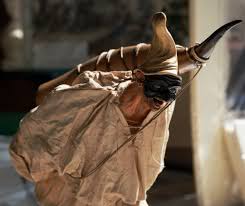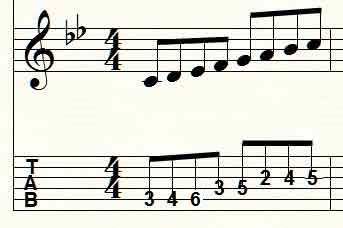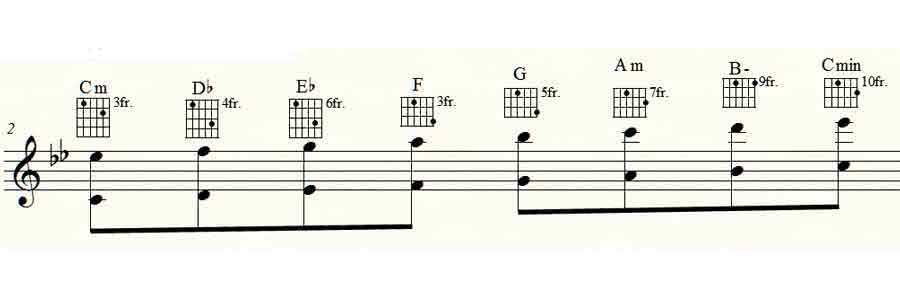The Neapolitan Scale
Exploring Exotic Modes - Part 1
Hi guys, this article is about one very particular exotic guitar scale ; it has been written by Danielle O'Hallisey, a guitarist/composer living in the wilds of Worcester, Vermont, USA. A student of Larry Coryell, she has recently been honored with a creation grant by the Vermont Arts Council to compose, perform and record new works for her neoclassical trio, Yellow Sky. Danielle will show you the Neapolitan Major Scale and how to approach and study a new mode. Enjoy this article! Gianca.
 My dad used to have a saying, that the hardest and most important words in the English language are these; "I don’t know". Difficult because our egos will block our admitting to the need for help implied in that phrase, important because we will never ask if we insist on looking like we already know what we clearly do not, so will never learn new things.
My dad used to have a saying, that the hardest and most important words in the English language are these; "I don’t know". Difficult because our egos will block our admitting to the need for help implied in that phrase, important because we will never ask if we insist on looking like we already know what we clearly do not, so will never learn new things.
I was first exposed to guitar scales other than the traditional major and minor way back in the 1970’s. Eminent fusion great John McLaughlin had come out with a book of miniature scores for some of the best work of the Mahavishnu Orchestra , and in the back there was a short appendix featuring such tantalizingly new concepts in modality as the " Enigmatic Mode .
I was a pretty good reader so I pulled out my guitar and crawled through each , like a chef sampling exotic ingredients ripe with unexplored possibilities. Unlike a seasoned chef, however, I lacked the understanding to see a path forward. How would I use these tasty tidbits in my next musical "meal?" I didn’t know, and didn’t admit that, so they quickly fell by the wayside without my exploring any of them further.
Fast forward to the now, after some time studying with that other giant of fusion guitar, Larry Coryell , and his patient insistence that I learn to be less lazy in my pursuit of musical knowledge, and I find myself with a fairly direct manner of approaching new scales , a bit of understanding about improvising and composing with them, and a few words of advice to the modal newcomer first encountering this information.
When Gianca and I discussed my writing for his website, I asked for a little guidance as to topic and he responded that I should visit this website and see if anything inspired me. A few minutes later I had downloaded his " 40 Exotic Guitar Scales Patterns " guide and was deeply immersed in exploration of the Neapolitan mode ; just because. And it quickly yielded insights into its mood, tone and effective uses that might have stayed hidden to a younger version of myself. Let’s take a look together, and see what we learn about this strange brew of tonal ingredients.
The Neapolitan Scale
One of the most interesting things about approaching a new mode is the way the brain leaps to conclusions before getting all of the information. This scale has the familiar 1–b2–b3 of the Phrygian Mode , a "cold" sounding minor scale—but then it also has the 4-5-6-7 of a standard Ionian, major diatonic , scale. So which is it? Major, or minor?
This actually points to the first important step in approaching new scales; you will use your brain to detect patterns no matter whether you try hard, a little or not at all. You can even try not to try, but your brain is conditioned through a long evolutionary thread to look for patterns , so it’s going to happen either way! Why not take that skill, give your fingers a brief rest, and really look at this new information?
So yes, you see that the third degree of the scale is the flatted third , making this a nominally "minor" scale. What other similarities to familiar scales do you see? As already stated, the latter half is more typical of a major scale, but then again the scale that is most like this mode is the jazz minor mode, which is identical to the melodic minor ascending scale : 1-2-b3-4-5-6-7 . The difference of this flatted second makes an important distinction, but this is at least one starting point for our explorations. We’ll see another, unexpected one, when we return to analysis in the next installment, then look at a short study for guitar in this mode in episode three. But for now; let’s have a look at how this initial insight prepares us for discovering the underlying tone of the Neapolitan Scale.
The Scale, Harmonies, and Chords of the Neapolitan Mode:
In this example I’ve created a custom key signature in my notation program to represent this unusual mode. Please keep this in mind as we look through our examples; I will not be placing accidentals (in this case, flats) before the 2nd and 3rd degrees of the scale each time they appear. The scale:

This is as good a place to learn the basic positioning and fingering of the mode as any, but please take the time to learn at least two locations for it at this time. I recommend this position (first finger on the third fret of the fifth string at the start, with a shift to put your first finger on the second finger of the third string when you get to that part of the scale) and then the same range, starting on the eighth fret of the sixth string. Each of these will illustrate our initial analysis; the left hand is used to playing the first part of the scale from the Phrygian mode , the latter part of the scale from the major diatonic. Run through the notes a few times, noodle around a little and see what you learn from this basic exploration.
Next, let’s kick the tires a little, and see how some familiar scalar patterns sound. I owe my gratitude to Coryell for this one, a series of thirds ascending then descending , followed by scalar passages bracketing those same intervals:

Play whichever scalar patterns you typically use to warm up or practice scales, but don’t spend too much time here at this point, because we now want to look at…
Neapolitan Mode Chords
Let’s start building up our basic chords , by adding a third to each note in the scale; we’ll add the fifth afterward. Notice how the chords at this point (without the fifth or seventh added) are already taking on a distinctive shape; i-II-III-IV-V-vi-vii(?)-i . These harmonies will get even weirder as we progress! Note that we run into an odd characteristic of exotic modes as we move into the vii chord; there is no “third” as we traditionally view it. No D or D#. Sure, there’s an Eb, but that doesn’t work in this case since it is already paired to the root (C) to imply a C minor. What we have to think in this case is that we’re looking at the third note above the B natural, so that’s B, C, Db. A second (or ninth) substituting for a third! I called it a B- chord for now , since it doesn’t fall under the traditional idea of a B chord.

Spend some time with this scale, with its strange harmonies and intriguing melodic concepts. Next time we’ll dig in, add the fifth to those chords and begin looking more deeply into improvising, and composing, with the Neapolitan mode .
Neapolitan Scale Notes In All The Keys
| 1 | b2 | b3 | 4 | 5 | 6 | 7 |
|---|---|---|---|---|---|---|
| C | Db | Eb | F | G | A | B |
| G | Ab | Bb | C | D | E | F# |
| D | Eb | F | G | A | B | C# |
| A | Bb | C | D | E | F# | G# |
| E | F | G | A | B | C# | D# |
| B | C | D | E | F# | G# | A# |
| F# | G | A | B | C# | D# | E# |
| Gb | Abb | Bbb | Cb | Db | Eb | F |
| C# | D | E | F# | G# | A# | B# |
| Db | Ebb | Fb | Gb | Ab | Bb | C |
| G# | A | B | C# | D# | E# | F## |
| Ab | Bbb | Cb | Db | Eb | F | G |
| D# | E | F# | G# | A# | B# | C## |
| Eb | Fb | Gb | Ab | Bb | C | D |
| A# | B | C# | D# | E# | F## | G## |
| Bb | Cb | Db | Eb | F | G | A |
| F | Gb | Ab | Bb | C | D | E |
Conclusions
Our journey into exotic scales stops for now, check the main guitar scale page to learn other cool sequences.